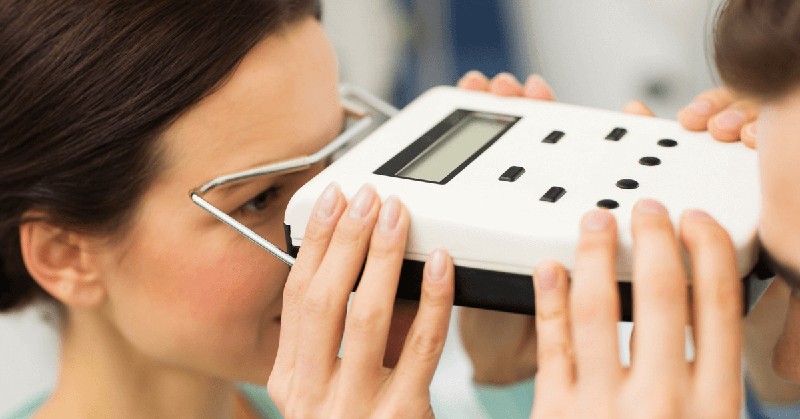Pupillometer Treatment of neurological disorders
Here’s why the pupillometer is gaining attention in healthcare industries. All That You Need to Know about Pupillometer, its types, applications, and advantages. Pupillometer is a medical device widely used in the ophthalmological and neurological departments. As vision-related problems and neurological disorders are progressively increasing, resulting in the increased demand for medical devices and equipment that can be used for the diagnosis and treatment of these diseases. A pupillometer records the movements and dilation of the pupil in the eyes, any deviation in the results obtained gives a clue about the deviation from the normal situation. Technological advancement and its integration in designing innovative medical devices are bringing waves in the field of medicine and it is anticipated to improve the healthcare facilities.
What is Pupillometer?
Pupillometer is a collective name for two devices. Both of them are used in ophthalmology. One of the devices is used to measures the distance between pupils through visual stimuli, and in another device, the light reflex of the pupil is measured. A programmed pupillometer is a portable device that is reliable to measure the size, reactivity, and symmetry of the pupil in response to light reflex. Pupillometry is a non-invasive method for assessment of pupil it is helpful in the neurological, and ophthalmological assessment.
Types of Pupillometer
Digital: The digital pupilometer is considered to give a precise and quick assessment of the size and activity of the pupil. A digital pupilometer is able to capture even the minor fluctuations in the pupillary response. This device captures different frames in a fraction of seconds and that is calculated and analyzed to determine the dilation of the pupil.
Video: A video pupillometer is a modified form. It is helpful in capturing the complete activity of pupil dilation. This result can be further analyzed to provide a complete understanding of the changes and causes for the same. NeurOptics, a pupillometer manufacturing company has launched several video pupillometers that are used in critical care units and in applied research. They are helpful for the clinicians in providing improved care to the patients.
Role of Pupillometer in the healthcare industry
From the studies of imaging modalities such as computerized tomography, and magnetic resonance imaging, it is shown that dilation of the pupil is directly related to the change in the activity of the brain. So Pupil dilation is helpful in understanding the normal function of the eye as well as the activity of the brain is impacted by any disease.
Pupil dilation offers clues about neurological disorders and helps in diagnosis. It is helpful in designing psychological treatments. Pupillometer is widely used in ophthalmology, oncology, and neurology.
Applications of Pupillometer
Pupillometer finds its application mainly in Hospitals and eye clinics. Several critical care units including cardiac intensive care, neurocritical care, surgical intensive care, medical intensive care, trauma, pediatric intensive care, and emergency department of the hospitals are adopting pupillometers for better diagnosis and treatment of disease.
Oncology
Pupillometry also assesses brain tumors and it is accomplished across various settings. For understanding the depth of anesthesia, a pupilometer is used. Many studies are being conducted with the help of a Pupillometer for understanding various health conditions like breast cancer, stroke, and thyroid tumor. The pupil size, its response to light, pupillary unrest, and other such characteristics of the pupil is the indicator of health conditions like head trauma, stroke, brain tumor, etc.
Neurology
The difference in the assessment of the results of the Pupillometer points out the damages of the nerves that may be associated with any brain injuries. Pupillary Light Reflex (PLR) is beneficial in examining the functions of the oculomotor and optical nerve. PLR assessment in turn is helpful in the assessment of a variety of neurological problems. If any deviation is observed in this assessment indicating the horizontal shift of the intracranial tissues.
Ophthalmology
In Eye clinics, there is an increasing application of pupillometer for inspection of pupil dilation, which is beneficial in assessing diseases related to the retina. Pupillometry identifies changes that may occur in the response of melanopsin and photoreceptors of the eye that helps in understanding damage on the inner and outer retina. Pupillary light reflex assists in evaluating the accurate functionality of the visual system.
Advantages of using Pupillometer
- It is a non-invasive method.
- Widely used in the diagnosis of ophthalmological problems.
- Pupillometer is relatively cost-effective compares to EEG, and, MEG.
- It is useful in the diagnosis of neurological disorders.
The bottom line
The Pupillometer Market has been showing rapid growth due to the increasing global burden for a neurological disorder and visual impairment day by day. Treatment of these disorders requires an accurate diagnosis in order to avail better treatment. Pupil dilation offers indications that are helpful in understanding the lives of people who have neurological disorders.
Due to advancement in technologies and their integration in designing medical devices is likely to improve the efficiency and efficacy of the Pupillometer. Manufacturing companies are researching on further use of pupillometer in different critical care fields to escalate the adoption of their product in different health care sectors.


Comments
Post a Comment